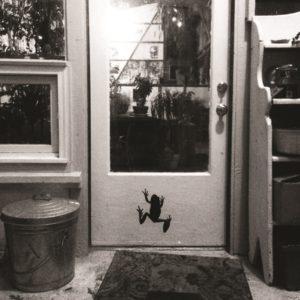It happens one night in early April. The air is warm, softened, the hard edges of winter worn away by gentle rain. In the woods, a sound that had almost been forgotten. Ah, yes. I know this sound. A far-off pitched vibration, a sound a thousand times the size of its origin, rising from the dusk. It’s the sound of spring.
That first night, the sound is that of a single soul inspired to sing. He wakes alone, driven by an instinct deep in his cells. This ancient species spends the winter nestled deep in the mud and decaying leaves. Now the longer days and warming air, running into the soil with the rain, tell him it is time. His little frog toes wriggle, his heart beats faster, and his hind legs kick. Just like the crocuses and hyacinth, he emerges through wet leaves. He sings.

The first peep sounds like a question. “Hello? Is anyone awake? Am I doing this right? Guys…?”
The days lengthen, more rain falls. And then there are many. Pseudacris crucifer, the chorus frog, spring peepers. The first few nights, the sound comes in waves, intense and then softer, highs and lows. More peepers push up through the ground. A thousand. A million. The whole night full of their sound. It becomes constant, so full it is material. You can feel it in your body. Your ears buzz with the pressure.
I have always listened to the peepers from my own human spaces: a grassy yard, a back deck with chairs and table, a well-worn trail in the woods.
One night last year, I wanted to hear them up close. To be with them. It was raining. A proper soaking spring downpour. Big drops smacking leaf litter, nothing left dry.
I walked into the wetland near my house, a vernal pool of moss and spongy ground that fills with water before it flowers and then dries come summer. The peepers went silent as I moved into their pond. I was still for a long moment. And then it began: The leaves and soil, tree bark and roots sang. The sound was so dense it felt like dark, deep water.
This is what they do as the light fades, their million peeps all made the same way, behind frog noses and mouths sealed closed, by air compressed in tiny lungs and pushed through a narrow passage into a chin pouch, swollen, taut and glistening, and screaming along the way.
They were everywhere. In the furrows in the oak bark, the hollows of the buttress roots of red maples, the fairy-tale caves in the clumps of arching blueberry. In every leaf, raft of moss, dip in the soft ground, there was a tiny olive-colored frog, each one a square inch of the vernal pool come to life. Or the world itself, calling out to create more life.
The male peeper frogs are the ones who call, who make this sound of spring from the southeastern United States up through central Canada. The females are drawn to the richer, lower tones. Out of 10,000 peeps, one will feel right, and she will move toward it. When a connection is made, she will lay up to a thousand eggs in the water. The male will immediately fertilize them.
There are some peepers called satellite males. This frog will sit next to a peeper with a richer song than his own. As the female approaches and the biological contract is signed, he will jump out before the chosen male does and fertilize her eggs.
But life goes on. Within a few days, if the nights remain warm, more peepers will be born. More sound will fill the dusk.



